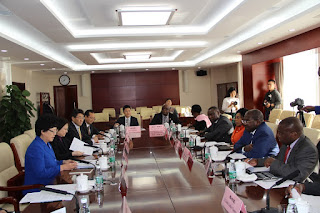Mighty Victoria Falls
By
NDUBI MVULA, Lusaka
THE United Nations World Tourism Organisation
(UNWTO) defines tourism as comprising the activities of persons travelling to and staying in
places outside their usual environment for not more than one consecutive year
for leisure, business and other purposes.
There are also other versions too many
to itemise but two can do for now.
And according to Parks and Recreation
management, Tourism
is defined as a
collection of activities, services and industries that delivers a travel
experience, including transportation, accommodations, eating and drinking
establishments, retail shops, entertainment businesses, activity facilities and
other hospitality services provided for individuals or groups travelling away
from home.
With all these accepted definitions of
the sector, there is yet another brand of tourism that somewhat may seem too
far a distance when it exists within the vicinity but not explored for all to appreciate
it.
Zambia’s Liaison Officer to the World
Tourism Organisation (UNWTO) Percy Ngwira this week takes on an exploration and
brings to fold what this brand of tourism is all about.
Dr Ngwira who is also First Secretary
for Tourism at the Zambian Embassy in Paris, France introduces this brand as Geotourism.
In his write-up of February 26th
2018, entitled “Geotourism and Geoparks: Is Africa missing
out on this new prospect for sustainable tourism development? Dr Ngwira explains
what this sector is all about and how it is harnessed.
He says despite great progress that has been
made in Africa in many spheres, debatebly there seem to be always 'the
followers' and not 'the leaders' in many things.
Dr Ngwira says geotourism and its
product geoparks seems to be 'the new kid on the block'.
However, as usual, Africa including
Zambia does not seem to be paying attention to this new wave of tourism
phenomenon spreading around the world like world fire.
So far, more than 125 Geoparks have been
established around the world with China in the lead having more than 30
Geoparks
“Yet, the whole of Africa we only have
one M'Goun UNESCO Global Geopark,
in Morocco, quite unbelievable,” he says.
However, Dr Ngwira explains geotourism
and geoparks are a relatively new phenomenon and subdivisions of geology and
tourism.
Though still in the infancy stage and
emerging as tourism niche markets awaiting further development and commercialisation,
Dr Ngwira says geotourism and geoparks have been credited as tools for
sustainable tourism with credentials to contribute to sustainable tourism
development, rural development, local community participation and poverty
alleviation.
He notes that the African continent
seems to be remaining behind in grabbing the opportunity of prospects presented
by this new niche tourism market.
And arguably, if there is a continent
under the sun that is blessed with geomorphological features and tourism
potential, “it is African”.
“From the spectacular natural
beauty of the Drakensberg mountains of South Africa to the ancients pyramids of
Egypt, from the cradle of mankind of the Ethiopian rift valley to
the rushing sand dunes of the Namib desert, from the world’s
best white sandy beaches of the Seychelles to the Historical Gold Coast of
West Africa, from the smoke thundering of water spray of the Mighty Victoria
Falls to the rich Serengeti plains overflowing with wild animals still roaming
the wilderness as it was at the beginning, these are some of the unspoilt
wonders that Africa still offers humanity beyond comparison to any other
continent,” said Dr Ngwira.
Therefore, Dr Ngwira says the
geomorphological and tourism riches of the great continent are unimaginable.
He says in the 21st century,
global tourism development must be ecologically sustainable, and shifting the
emphasis from other forms of sustainable tourism like ecotourism to geotourism
represents a positive step towards more sustainable global tourism.
“National Geographical Centre for
Sustainable Destinations documents that Geotourism is sustainable tourism
energised. It sustains, but it can also enhance by means of restorative and
constructive forms of tourism that fit the nature of the destination,” he says.
Dr Ngwira further explains that tourist
revenue can help to restore historic districts, for instance, and support local
craftspeople.
And that it can help to preserve and
develop local cuisines, based on distinctively local ingredients supplied by
local farmers as well as help to retain traditional cultural celebrations and
performing arts that would otherwise disappear.
“It can help to beautify ugly places and
enrich poor places. It does those things best when focused on the
distinctiveness of a place, avoiding the destructive pitfalls of undifferentiated
global mass tourism,” he says.
Dr Ngwira says geotourism development at
the local and regional levels must be developed within the context of
sustainable local, national and international tourism development.
He says at the local, regional and
national levels, development policies, plans and programs, laws and
regulations, and marketing, all influence sustainable tourism development.
Dr Ngwira advises that the three main
principles of sustainable development which can also be applied to regional
geotourism development planning are its concentration on ecological, social and
economic issues.
“Therefore, geotourism will only be
sustainable where there are benefits for the host community, and these may be
social and or cultural, and environmental and will not necessarily be confined
to economic benefits,” he says.
As the motto for Zambia Tourism Agency “Zambia,
Let’s Explore”, it goes without saying that in this journey of marketing
the country to the whole-wide-world, exploring all means sustainable at hand is
the key.




